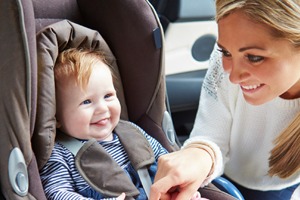
Keeping your child safe when driving in a vehicle is of the utmost importance. Thousands of young children are seriously injured and killed in car crashes each year. Proper use of car seats helps to keep children safe. With so many car seats on the market, how do you know which car seat is the best for your child?
Your child’s stage of growth and development determines which type of car restraint is right for him or her:
Which stage should you use?
The weight and size of your child will help determine which stage car seat is best. All child seats are different so make sure you read the label carefully to ensure the child fits the seat before you buy it.
Below are some general guidelines:
Stage 1: Infants/Toddlers – Rear-facing only seats and rear-facing convertible seats – All infants and toddlers should ride in a Rear-Facing Car Seat until they are at least 2 years of age or until they reach the highest weight or height allowed by their car seat’s manufacturer.
Stage 2: Toddlers/Preschoolers – Convertible seats and forward-facing seats with harnesses – Any child who has outgrown the rear-facing weight or height limit for their convertible car seat should use a Forward-Facing Car Seat with a harness for as long as possible, up to the highest weight or height allowed by their car seat manufacturer.
Stage 3: School-Aged Children – Booster seats – All children whose weight or height is above the forward-facing limit for their car seat should use a Belt-Positioning Booster Seat until the vehicle seat belt fits properly, typically when they have reached 4 feet 9 inches in height and are between 8 and 12 years of age.
Stage 4: Older Children – Seat Belts – When children are old enough and large enough for the vehicle seat belt to fit them correctly, they should always use Lap and Shoulder Seat Belts for optimal protection. All children younger than 13 years should be restrained in the rear seats of vehicles for optimal protection.
– When buying a children’s car seat or booster seat use the chart to find the stage the child is at and the type of car seat needed.
– Make sure the child fits the weight and height limits of the seat you are considering
– Test to make sure the child fits in the seat
– Place him or her in the seat and make sure it’s comfortable
– Test to make sure the car seat can be installed properly in your vehicle
– Send in the product registration card after you buy the child seat
Important Child Car Seat Tips
When it comes to children’s safety in your vehicle remember these tips:
– Do not rush to move a child from one stage to the next. As long as he or she is still in the right weight and height range of the car seat, it is safer to use the current children’s car seat.
– Some children’s car seats can be used for more than one stage. Check your children’s car seat user guide for details about this and to make sure you are using it correctly.
– By law, children must be buckled-up in a children’s car seat appropriate to their size and weight.
– The safest place for children 12 and under is the back seat of your car, in the right restraint.
– Do not leave a baby unattended in his or her infant car seat when in or outside of your vehicle. Many seats can tip over easily when your baby moves. Always put an infant car seat on the floor – not on a table or chair – and make sure nothing around it can fall on the baby. An infant car seat should never be used as a crib.
– You should replace the seat if it is past its expiry date, has been in a collision, is worn or no longer meets the specifications of the child’s size.
The experienced lawyers at Cariati Law can help you or a loved one when injured in a car accident, a slip & fall accident or any type of accident. Call Cariati Law with offices in Toronto and Mississauga for a free, no obligation, confidential consultation at 905-629-8040. There is never a fee for our services unless we win for you.
Our lawyers are committed to protecting your rights. When injured, Make One Call to Cariati Law.
Cariati Law, Passion Behind Every Case.
